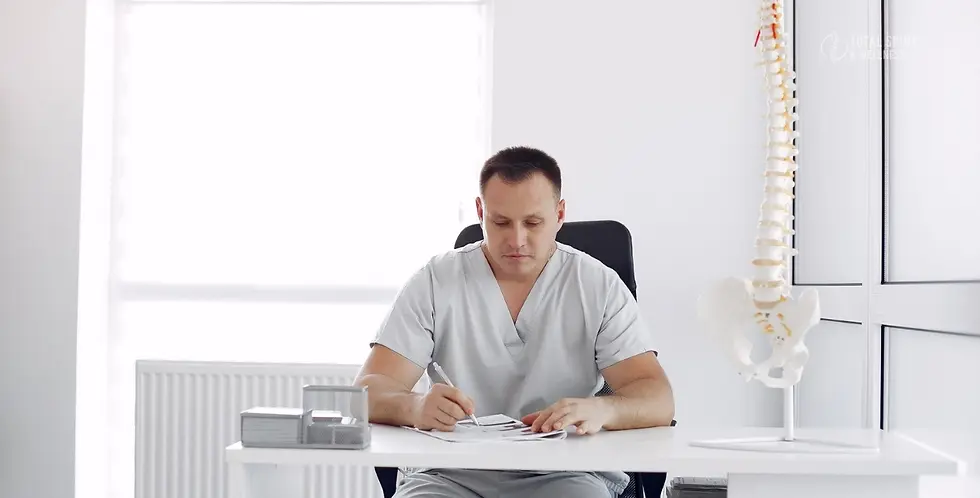Understanding Spinal Disc Degeneration and Natural Regeneration: A New Era in Spine Health
- abdallahslem064
- Oct 28
- 3 min read
Understanding Spinal Disc Degeneration
Spinal discs act as cushions between the vertebrae, allowing the spine to bend, absorb shock, and move smoothly. Over time, these discs can lose hydration and elasticity — a process known as disc degeneration. Age, genetics, repetitive stress, and lifestyle factors such as prolonged sitting or smoking can all accelerate this process. When a disc deteriorates, it may lead to chronic pain, stiffness, and even nerve compression.
While surgery remains an option in severe cases, researchers and clinicians are increasingly focusing on natural and regenerative methods to promote disc healing and slow degeneration.
The Body’s Natural Healing Potential
The human body possesses an incredible ability to repair tissue, including the components of spinal discs. However, discs have limited blood supply, which makes self-repair slower compared to other tissues. This has led scientists and spine specialists to explore treatments that enhance the body’s own regenerative mechanisms rather than replacing the disc entirely.
Some of the most promising approaches include:
Physical rehabilitation and movement therapy, which improve circulation and nutrient delivery to spinal structures.
Anti-inflammatory nutrition, emphasizing omega-3 fatty acids, antioxidants, and hydration to reduce oxidative stress.
Regenerative injections such as platelet-rich plasma (PRP) or stem-cell–based therapies, designed to stimulate tissue growth and disc hydration.

Emerging Regenerative Medicine Therapies in the U.S.
Across the United States — particularly in innovation-driven states like Florida — regenerative medicine has become a cornerstone of spine care. Clinics specializing in spine and orthopedic health are integrating biologic therapies that use a patient’s own cells to encourage disc renewal. Unlike traditional open surgeries, these methods are minimally invasive, performed on an outpatient basis, and aim to restore disc function naturally.
Florida’s healthcare system, known for adopting advanced medical technologies, has played an active role in researching these methods. Collaborative efforts between universities and private spine centers have led to protocols that show encouraging results in patients with mild to moderate degenerative disc disease.
Lifestyle Strategies That Support Disc Regeneration
Even outside the clinic, lifestyle factors can make a measurable difference in spinal health. Experts recommend:
Consistent low-impact exercise such as swimming, walking, or yoga to maintain flexibility and core strength.
Proper posture and ergonomics, especially for individuals who work long hours at a desk.
Adequate sleep and hydration, which allow spinal discs to reabsorb fluids overnight.
Weight management and smoking cessation, both of which improve nutrient delivery to spinal tissues.
Although these steps may not “regrow” discs overnight, they create the ideal environment for regeneration and help prevent further degeneration.

Scientific Outlook on Natural Disc Regeneration
Recent studies have explored how growth factors and biologic scaffolds can support disc repair. Laboratory findings show that introducing certain cell types or stimulating natural growth proteins can rejuvenate the inner disc material (nucleus pulposus) and restore flexibility. While more long-term research is still needed, these advancements suggest a future where patients can rely less on surgery and more on biologically guided healing.
For individuals interested in understanding how natural methods and regenerative techniques intersect, you can learn more about ongoing approaches and supportive strategies being explored by healthcare professionals across the U.S.
The Future of Spine Care
The idea of regenerating spinal discs naturally once sounded impossible, yet modern medicine continues to push boundaries. Through a combination of scientific innovation, healthy lifestyle practices, and minimally invasive therapies, patients now have access to options that were unimaginable a generation ago.
Florida’s growing network of regenerative spine centers — including those focused on Total Spine Wellness — illustrates how this field is rapidly evolving, offering hope that one day, spinal disc regeneration may become a standard part of conservative treatment for back pain.

Comments